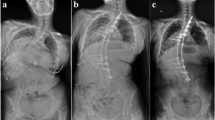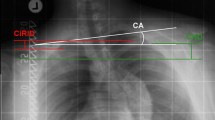Abstract
Purpose
To identify factors that can affect postoperative shoulder balance in AIS.
Method
89 adolescent idiopathic scoliosis patients with six types of curvatures who underwent surgery were included in this study. Whole spine antero-posterior and lateral radiographs were obtained pre- and postoperatively. In radiograms, shape and changes in curvatures were analyzed. In addition, four shoulder parameters and coronal balance were analyzed in an effort to identify factors significantly related to postoperative shoulder balance.
Result
In general, all the four shoulder parameters (CHD, CA, CRID, RSH) were slightly increased at final follow up (t test, P < 0.05), although there was a decrease in Lenke type II and IV curvatures. However, pre- and postoperative shoulder parameters were not significantly different between each curvature types (ANOVA, P > 0.05). Moreover, no significant differences of pre- and postoperative shoulder level between different level of proximal fusion groups (ANOVA, P > 0.05) existed. In the analysis of coronal curvature changes, no difference was observed in every individual coronal curvatures between improved shoulder balance and aggravated groups (P > 0.05). However, the middle to distal curve change ratio was significantly lower in patients with aggravated shoulder balance (P < 0.05). In addition, patients with smaller preoperative shoulder imbalance showed the higher chance of aggravation after surgery with similar postoperative changes (P < 0.05).
Conclusions
Significant relations were found between correction rate of middle, and distal curvature, and postoperative shoulder balance. In addition, preoperative shoulder level difference can be a determinant of postoperative shoulder balance.




Similar content being viewed by others
References
Asher M, Min Lai S, Burton D, Manna B (2003) The reliability and concurrent validity of the scoliosis research society-22 patient questionnaire for idiopathic scoliosis. Spine (Phila Pa 1976) 28:63–69
Asher MA, Lai SM, Glattes RC, Burton DC, Alanay A, Bago J (2006) Refinement of the SRS-22 health-related quality of life questionnaire function domain. Spine (Phila Pa 1976) 31:593–597
Haher TR, Gorup JM, Shin TM, Homel P, Merola AA, Grogan DP, Pugh L, Lowe TG, Murray M (1999) Results of the scoliosis research society instrument for evaluation of surgical outcome in adolescent idiopathic scoliosis. A multicenter study of 244 patients. Spine (Phila Pa 1976) 24:1435–1440
Haher TR, Merola A, Zipnick RI, Gorup J, Mannor D, Orchowski J (1995) Meta-analysis of surgical outcome in adolescent idiopathic scoliosis. A 35-year English literature review of 11,000 patients. Spine (Phila Pa 1976) 20:1575–1584
Li M, Gu S, Ni J, Fang X, Zhu X, Zhang Z (2009) Shoulder balance after surgery in patients with Lenke Type 2 scoliosis corrected with the segmental pedicle screw technique. J Neurosurg Spine 10:214–219
Qiu XS, Ma WW, Li WG, Wang B, Yu Y, Zhu ZZ, Qian BP, Zhu F, Sun X, Ng BK, Cheng JC, Qiu Y (2009) Discrepancy between radiographic shoulder balance and cosmetic shoulder balance in adolescent idiopathic scoliosis patients with double thoracic curve. Eur Spine J 18:45–51
Raso VJ, Lou E, Hill DL, Mahood JK, Moreau MJ, Durdle NG (1998) Trunk distortion in adolescent idiopathic scoliosis. J Pediatr Orthop 18:222–226
Sanders JO, Polly DW Jr, Cats-Baril W, Jones J, Lenke LG, O’Brien MF, Stephens Richards B, Sucato DJ (2003) Analysis of patient and parent assessment of deformity in idiopathic scoliosis using the walter reed visual assessment scale. Spine (Phila Pa 1976) 28:2158–2163
Smith PL, Donaldson S, Hedden D, Alman B, Howard A, Stephens D, Wright JG (2006) Parents’ and patients’ perceptions of postoperative appearance in adolescent idiopathic scoliosis. Spine (Phila Pa 1976) 31:2367–2374
Ilharreborde B, Even J, Lefevre Y, Fitoussi F, Presedo A, Souchet P, Pennecot GF, Mazda K (2008) How to determine the upper level of instrumentation in Lenke types 1 and 2 adolescent idiopathic scoliosis: a prospective study of 132 patients. J Pediatr Orthop 28:733–739
Smyrnis PN, Sekouris N, Papadopoulos G (2009) Surgical assessment of the proximal thoracic curve in adolescent idiopathic scoliosis. Eur Spine J 18:522–530
Lenke LG, Betz RR, Haher TR, Lapp MA, Merola AA, Harms J, Shufflebarger HL (2001) Multisurgeon assessment of surgical decision-making in adolescent idiopathic scoliosis: curve classification, operative approach, and fusion levels. Spine (Phila Pa 1976) 26:2347–2353
Lenke LG, Betz RR, Harms J, Bridwell KH, Clements DH, Lowe TG, Blanke K (2001) Adolescent idiopathic scoliosis: a new classification to determine extent of spinal arthrodesis. J Bone Joint Surg Am 83-A:1169–1181
Puno RM, An KC, Puno RL, Jacob A, Chung SS (2003) Treatment recommendations for idiopathic scoliosis: an assessment of the Lenke classification. Spine (Phila Pa 1976) 28:2102–2114 (discussion 2114–2105)
Suk SI, Kim WJ, Lee CS, Lee SM, Kim JH, Chung ER, Lee JH (2000) Indications of proximal thoracic curve fusion in thoracic adolescent idiopathic scoliosis: recognition and treatment of double thoracic curve pattern in adolescent idiopathic scoliosis treated with segmental instrumentation. Spine (Phila Pa 1976) 25:2342–2349
Bago J, Carrera L, March B, Villanueva C (1996) Four radiological measures to estimate shoulder balance in scoliosis. J Pediatr Orthop B 5:31–34
Kuklo TR, Lenke LG, Graham EJ, Won DS, Sweet FA, Blanke KM, Bridwell KH (2002) Correlation of radiographic, clinical, and patient assessment of shoulder balance following fusion versus nonfusion of the proximal thoracic curve in adolescent idiopathic scoliosis. Spine (Phila Pa 1976) 27:2013–2020
Barr SJ, Schuette AM, Emans JB (1997) Lumbar pedicle screws versus hooks. Results in double major curves in adolescent idiopathic scoliosis. Spine (Phila Pa 1976) 22:1369–1379
Lenke LG, Bridwell KH, O’Brien MF, Baldus C, Blanke K (1994) Recognition and treatment of the proximal thoracic curve in adolescent idiopathic scoliosis treated with Cotrel–Dubousset instrumentation. Spine (Phila Pa 1976) 19:1589–1597
Suk SI, Lee CK, Kim WJ, Chung YJ, Park YB (1995) Segmental pedicle screw fixation in the treatment of thoracic idiopathic scoliosis. Spine (Phila Pa 1976) 20:1399–1405
Suk SI, Lee CK, Min HJ, Cho KH, Oh JH (1994) Comparison of Cotrel–Dubousset pedicle screws and hooks in the treatment of idiopathic scoliosis. Int Orthop 18:341–346
Akel I, Pekmezci M, Hayran M, Genc Y, Kocak O, Derman O, Erdogan I, Yazici M (2008) Evaluation of shoulder balance in the normal adolescent population and its correlation with radiological parameters. Eur Spine J 17:348–354
Trobisch PD, Samdani AF, Pahys JM, Cahill PJ (2011) Postoperative trunk shift in Lenke 1 and 2 curves: how common is it? and analysis of risk factors. Eur Spine J 20:1137–1140
Conflict of interest
None.
Author information
Authors and Affiliations
Corresponding author
Rights and permissions
About this article
Cite this article
Hong, JY., Suh, SW., Modi, H.N. et al. Analysis of factors that affect shoulder balance after correction surgery in scoliosis: a global analysis of all the curvature types. Eur Spine J 22, 1273–1285 (2013). https://doi.org/10.1007/s00586-013-2697-5
Received:
Revised:
Accepted:
Published:
Issue Date:
DOI: https://doi.org/10.1007/s00586-013-2697-5




